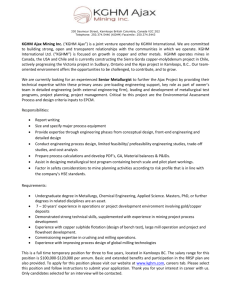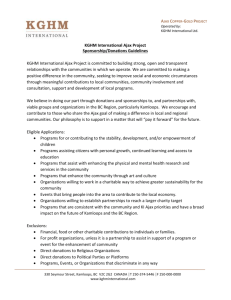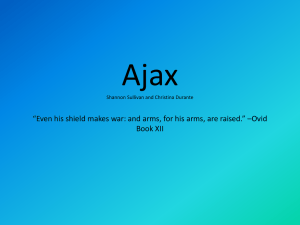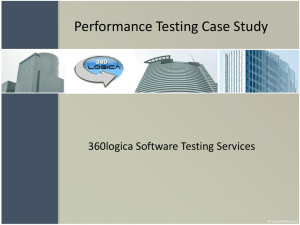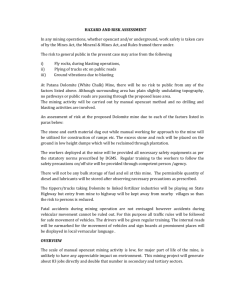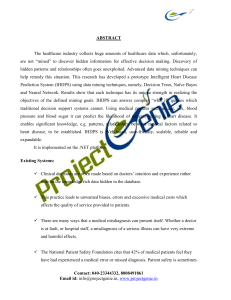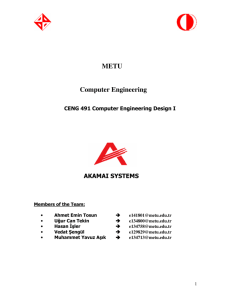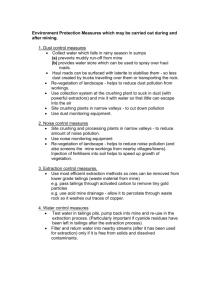Ajax Copper-Gold Project Fact Booklet
advertisement
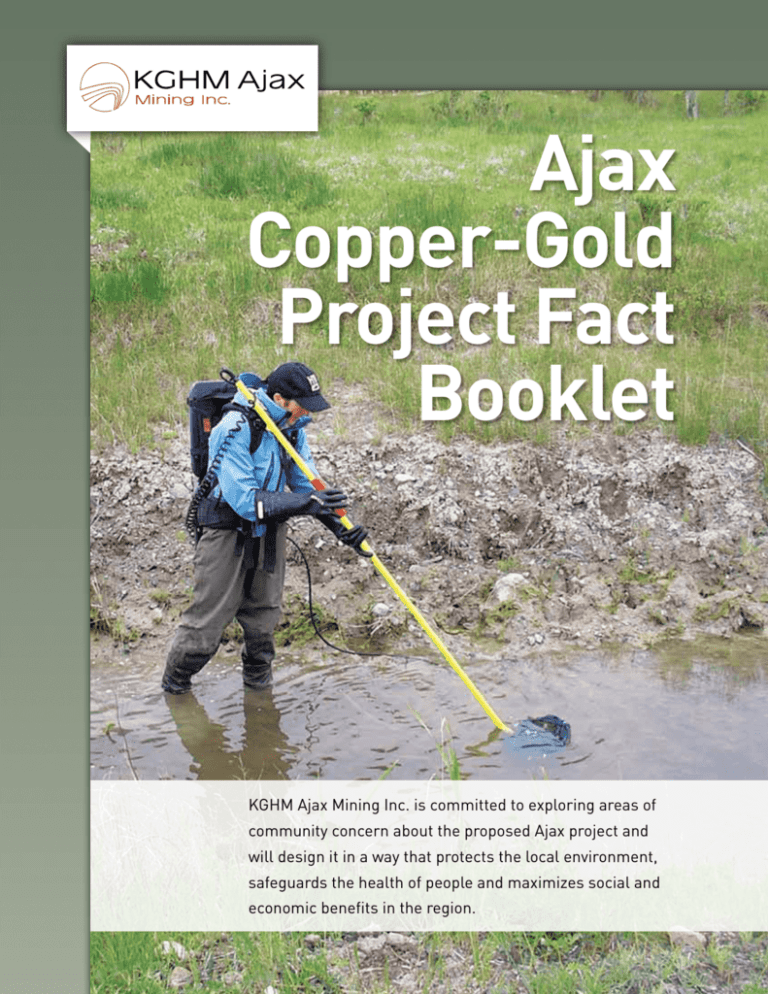
Ajax Copper-Gold Project Fact Booklet KGHM Ajax Mining Inc. is committed to exploring areas of community concern about the proposed Ajax project and will design it in a way that protects the local environment, safeguards the health of people and maximizes social and economic benefits in the region. The Ajax Copper-Gold Project: Building on a History of Mining Mining and mineral exploration have contributed to the growth and prosperity of the Kamloops region for more than a century and this resource-rich district hosts several historic and operating mines, along with many active exploration and development projects such as the Ajax project. Mineral exploration began in the Thompson Nicola region in the 1880s when copper, gold and iron mineralization was discovered at the Iron Mask Mine near Kamloops. The original Afton copper deposit was found by Chester F. Millar in the mid-1960s and was operated as the Afton Mine following Teck’s acquisition of Millar’s company. Teck operated the Afton mine – including two satellite pits, Crescent and Pothook – and the East and West Ajax pits from 1987 until 1997 when the mine closed. Exploration began at the Ajax deposit in 2005 and resulted in the discovery of a large low-grade copper-gold deposit. The project has been pursued ever since; firstly by Abacus Mining & Exploration Corp. and beginning in 2010, by KGHM Ajax Mining Inc. PROJECT DESCRIPTION The proposed Ajax project infrastructure includes: an open pit, a processing plant, a thickened tailings storage facility, two waste rock facilities, explosives storage and access roads. Ajax Pit Tailings Storage Facility Design size of 261 hectares at life of mine. 3.0km L x 1.4km W x 150m H Size of up to a maximum of 376 hectares at life of mine. The project will use conventional blast, load and haul methods. Initially, mined ore will be moved by truck but later in the mine life, inpit crushing, conveyance and waste stacking systems will partially replace trucks moving the ore. Processing Plant Will be built in a valley to form a natural barrier from Kamloops and Jacko Lake. Trans -Ca nad a Proposed design is a single free standing compound with raised embankments. Thickened tailings require less fresh water than conventional tailings. Rock will be used to construct the surface erosion cover and provide a solid base for concurrent reclamation. Copper and gold are separated from the ore using a conventional flotation process. Hw yW Waste Rock Management Facilities North Waste Dump: 1.9km L x 2.3km W x 140m H East Waste Dump: 1.5km L x 1.9km W x 100m H Dust will be minimized using water and binding agents. In later mine life, trucks will partially be replaced by conveyance and stacking systems, which reduce noise and dust. Explosives Storage Will be built on the south side of the mine property. Trucks will transport and load blast agents for once-daily blasting. CITY OF KAMLOOPS 2.3 km North Waste Rock Management Facility Tailings Storage Facility Processing Plant Ajax Pit 1.6km 1.5 km Vibration and noise will be reduced using computer-timed detonation. East Waste Rock Management Facility Access Roads Currently accessed via the existing Afton Mine haul road. Jacko Lake view will be protected by building a new access road from the mine area to Lac Le Jeune Highway. Concentrate will be transported via Lac Le Jeune Highway to the Port of Vancouver. Explosive Storage 0 500 1,000 1,500 Many mines around the world are located near towns and cities, including several successful projects in Canada. In Ontario, Goldcorp operates its combined underground and open-pit Porcupine Joint Venture within the city limits of Timmins; and 12 mines are in operation today within Sudbury city limits. In Quebec, the Dubuisson Gold Property – currently under development by Metanor Resources – will be located entirely within the city limits of Val-d’Or. 2,000 Meters MINING THE AJAX COPPER-GOLD PROJECT KGHM Ajax will design its mine plan to ensure any adverse environmental effects resulting from the disturbance of naturally occurring elements are mitigated. The proposed Ajax project will extract copper and gold - which occur as sulphides - from the open pit. As is typical in the region, rocks within the project footprint contain only two percent sulphide mineralization. The bulk of the rock mass is composed of common elements such as oxygen, silicon, aluminum, iron, calcium, sodium, potassium and magnesium. Extracting Ore from the Ground The mining process begins with blasting the rock to loosen it from the ground. KGHM Ajax will blast once a day, which will last less than five seconds. As an explosive for blasting, mines commonly use ANFO, a mixture of 94-percent ammonium nitrate and six-percent fuel oil. ANFO is a blasting agent, not a high explosive. It will be safely transported and stored at the site and will be handled by certified blasters. After the ore is blasted, it will be crushed in two separate stages prior to grinding and flotation. Chemicals Used in the Mining Process All mines use chemicals to separate the desired minerals from the waste materials. The Ajax project will use the same chemicals found in copper mines locally and around the world, including: • Methyl Isobutyl Carbional (MIBC) – Creates a stable flotation process. • Potassium Amyl Xanthate (PAX) - Allows the valuable metal particles to separate from other less valuable particles. • Lime – Keeps the solution at the correct level of acidity. • Flocculent – A clarifying agent that promotes liquid/solid separation. Removing the Copper Following the crushing process, the ore will be ground into very fine particles to separate the valuable copper and gold minerals from waste materials. The particles will be mixed with water and chemicals to undergo a process called ‘froth flotation’, which creates a copper concentrate containing recoverable gold. 2. Crushing 3. Grinding and Flotation 4. Thickening 1. Mining 5. Tailings Copper Concentrate Copper concentrate will be thickened and filtered to remove excess water and then transported by sealed transport trucks in preparation for shipment to overseas markets for smelting and refining. Tailings The waste materials remaining after the copper concentrate is removed is known as ‘tailings’. The Ajax tailings will contain naturally-occurring trace levels of sulphides and will be thickened with a chemical binder before being stored in the Tailings Storage Facility. All water that comes in contact with the tailings will be diverted to the Inks Lake catchment area for re-use back through the process plant. There will be no cyanide or mercury used on the Ajax site or produced as a by-product of any part of the Ajax mining or concentrate-producing process. WATER USE AND WATER QUALITY The proposed Ajax project is a ‘zero discharge’ facility. This means all water that comes in contact with the mine is captured on site and recycled back to the mining and milling process. The project lies within the Peterson Creek and Cherry Creek watersheds, both of which flow into Kamloops Lake. Ajax has been studying fisheries and aquatic resources in this area since 2007. To date, data collected includes stream flow measurements, seasonal fluctuations of groundwater levels, water quality samples, fish species and fish habitats. Benefits of a Zero Discharge Facility •Minimizes the need for ‘new’ water from sources outside the mine site. •Contributes to the preservation of water quality in the local watersheds. KGHM Ajax will use this data to examine how the project could affect the local fisheries and aquatic resources. The Ajax project will be designed in such a way that protects fisheries and aquatic resources and mitigates any adverse environmental impacts. Jacko Lake is a popular fishing lake that is stocked annually with rainbow trout. KGHM Ajax will adhere to all regulations and will work to preserve the lake, the fish stocks and the recreational fishing opportunities in Jacko Lake. Peterson Creek currently runs through the proposed mine site area next to the existing open pits. In the current Ajax project plan, a 1,500 metre section will be diverted to minimize any potential impacts to the creek. KGHM Ajax is compiling baseline data to ensure the integrity of the water quality remains consistent or improves over the life of the Ajax project. Cherry Creek watershed flows northwest from Greenstone Mountain into Kamloops Lake – which is primarily used for irrigation and stock watering. No diversion or disturbance is planned for Cherry Creek. Naturally-occurring sulphates tend to be highly concentrated in Inks Lake, making it uninhabitable by fish and other aquatic life. In the current Ajax project plan, Inks Lake will be used as a catchment for surface run off and a source of water for the mine process plant. In the current Ajax project plan, water will be pumped from Kamloops Lake for use in the mining process. However, the mine will only use 0.2% of the Kamloops Lake water flow. Ranchers and other local residents hold water-use licences on Peterson Creek. KGHM Ajax will protect the volume and quality of water in Peterson Creek. DUST FALL By its very nature, mining produces dust. In open-pit mining, dust is a result of blasting, crushing and dumping rock. The speed and distance dust travels is affected by wind, weather and the size of dust particles. Studying Dust KGHM Ajax is studying existing dust fall and air quality in the project area. To better understand how much more dust the mine will produce, KGHM Ajax is collecting weather and climate data, working with industry experts and using the highest level of dust study models available to predict dust fall. KGHM Ajax will develop a dust mitigation plan that meets or exceeds current best management practices. The project will be designed in such a way that mitigates environmental and health issues related to dust. Managing Dust KGHM Ajax will use best practices for dust management by identifying and controlling dust at its source during all phases of the mining operations. Dust control methods include: • Watering and applying binding agents to roads. • Watering and applying binding agents to waste rock piles. • Enclosing stockpiles. • Enclosing crushing facilities and conveyor transfer points. • Using water sprays where necessary. • Using best available reclamation techniques. Binders Used in Dust Control Magnesium chloride and calcium chloride are typical chemicals used to bind dust and keep it from becoming airborne. Both of these compounds absorb moisture from the air and cause dust particles to stick to one another. These compounds can also be used as food additives and are not found to harm humans, animals or plants. BLASTING IN MINING In both underground and open-pit mining, blasting is necessary to recover the metal-containing ore. Blasting typically results in both ground vibration and noise. The level of noise and vibration and the degree to which it is felt by an individual depends on many factors such as time of day, weather, frequency of occurrence and individual sensitivity. KGHM Ajax conducted site-specific test blasts in February 2011. The blast vibrations were found to be below the vibration limit adopted by many North American municipalities. As such, blast vibrations for the Ajax project are expected to be below a level typically felt or heard by people and the vibration will not cause structural problems to the surrounding residential areas. Blasting and Noise Control KGHM Ajax recognizes it will need to control blasting and the resulting vibration and noise. The Ajax project will use high-precision computercontrolled blasting techniques to control vibration and noise. As the Environmental Assessment process continues and the Ajax project plan is further refined, KGHM Ajax will identify measures that can be implemented to reduce noise and vibration levels including: • Elimination of noise sources. • Purchasing equipment with improved noise characteristics. • Proper maintenance of equipment. • Enclosure or shielding sources of noise. • Suppression of the noise at source. BRINGING SIGNIFICANT BENEFITS TO THE KAMLOOPS REGION Over its two-year construction phase and 23-year mine life, the proposed Ajax project will provide a significant economic boost to the City of Kamloops in the form of jobs, local spending and tax revenues. The project is expected to provide lasting economic benefits even after the project is completed. JOBS Average annual jobs during the construction phase. Average annual jobs during operation. Indirect: 750 Indirect: 490 Direct: 580 Direct: 380 The average annual salary for a mining job is $100,000. ECONOMIC STIMULUS $1.1 million to be spent per day during construction. $180 million to be spent per year during operation. Kamloops Spending: 37% Consumables (parts, materials, etc.): 51 % BC Spending: 35% Wages: 22 % Canadian Spending: 27% Power: 14% Foreign Spending: 1% Services: 5 % ESTIMATED TAX REVENUE OVER THE MINE’S LIFETIME Federal and Provincial: $550 million BC Mining Act Tax: $210 million Municipal: $110 million Fuel: 8 % ABOUT THE AJAX COPPER-GOLD PROJECT The Ajax project is a proposed open-pit copper-gold mine located near Kamloops, British Columbia. Plans call for a 60,000-tonne-per-day mine expected to produce 109 million pounds of copper and 99,000 ounces of gold annually. Mine life is estimated to be 23 years. If the project is approved, it would generate 580 construction jobs, 380 full-time jobs during operations, plus significant tax revenue, royalties and benefits for governments, local communities and First Nations, including the Tk’emlúps and Skeetchestn Indian Bands. The project is a joint venture between Vancouver-based Abacus Mining and Exploration Corporation and KGHM Polska Miedz S.A., a leading global copper and silver producer. The proposed project will undergo a single coordinated assessment as provided for in the Canada-BC Agreement on Environmental Assessment Cooperation. The Application for the proposed project will be assessed by the Canadian Environmental Assessment Agency (CEA Agency) and the BC Environmental Assessment Office (EAO). Additional information about the environmental assessment process is available on the CEA Agency’s website at www.ceaa-acee.gc.ca and the EAO’s website at www.eao.gov.bc.ca. KGHM Ajax Mining Inc. 330 Seymour Street Kamloops, BC, V2C 2G2 T (250) 374-KGHM (5446) E info@ajaxmine.ca W www.ajaxmine.ca
